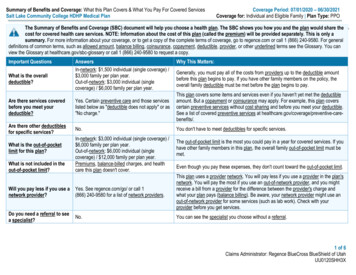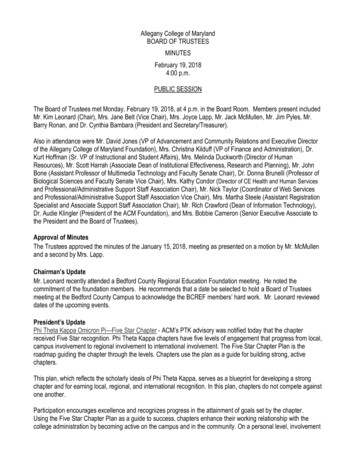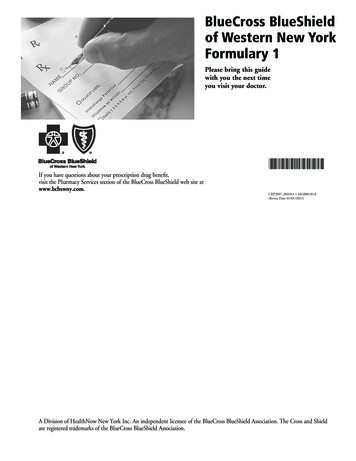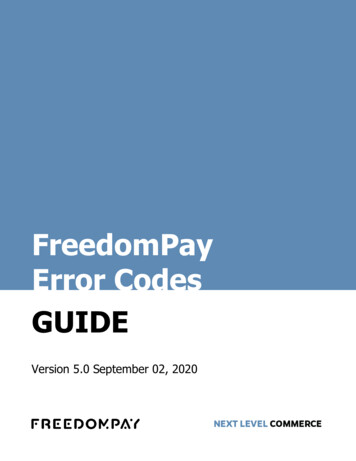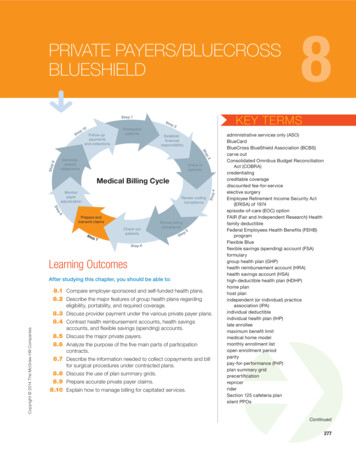
Transcription
PRIVATE PAYERS/BLUECROSSBLUESHIELDS te p 1SteSt10epFollow uppaymentsand collectionsPreregisterpatientsKEY eneratepatientstatementsCheck inpatientsReview codingcomplianceStep4Medical Billing CycleMonitorpayeradjudicationStep8Prepare andtransmit claimsS teCheck outpatientsReview billingcompliancep7Step5S tep 6Learning OutcomesAfter studying this chapter, you should be able to:8.1 Compare employer-sponsored and self-funded health plans.8.2 Describe the major features of group health plans regardingeligibility, portability, and required coverage.8.3 Discuss provider payment under the various private payer plans.8.4 Contrast health reimbursement accounts, health savingsCopyright 2014 The McGraw-Hill Companies8accounts, and flexible savings (spending) accounts.8.5 Discuss the major private payers.8.6 Analyze the purpose of the five main parts of participationcontracts.8.7 Describe the information needed to collect copayments and billfor surgical procedures under contracted plans.8.8 Discuss the use of plan summary grids.8.9 Prepare accurate private payer claims.8.10 Explain how to manage billing for capitated services.administrative services only (ASO)BlueCardBlueCross BlueShield Association (BCBS)carve outConsolidated Omnibus Budget ReconciliationAct (COBRA)credentialingcreditable coveragediscounted fee-for-serviceelective surgeryEmployee Retirement Income Security Act(ERISA) of 1974episode-of-care (EOC) optionFAIR (Fair and Independent Research) Healthfamily deductibleFederal Employees Health Benefits (FEHB)programFlexible Blueflexible savings (spending) account (FSA)formularygroup health plan (GHP)health reimbursement account (HRA)health savings account (HSA)high-deductible health plan (HDHP)home planhost planindependent (or individual) practiceassociation (IPA)individual deductibleindividual health plan (IHP)late enrolleemaximum benefit limitmedical home modelmonthly enrollment listopen enrollment periodparitypay-for-performance (P4P)plan summary gridprecertificationrepricerriderSection 125 cafeteria plansilent PPOsContinued277
KEY TERMSstop-loss provisionsubcapitationSummary Plan Description(SPD)TIPHIPAHHITECA/Group Health PlanRegulationEmployer-sponsored grouphealth plans must follow federaland state laws that mandatecoverage of specific benefits ortreatments and access to care.When a state law is more restrictive than the related federal law,the state law is followed.(continued)third-party claimsadministrators (TPAs)tiered networkutilization reviewutilization review organization(URO)waiting periodMedical insurance specialists must become knowledgeable about the billing rules ofthe private plans that insure their patients, especially how they affect coverage of services and financial responsibility. This chapter covers procedures for billing underthe leading types of managed care plans. Also covered are plans with funding optionscontrolled by patients, which have become a popular insurance model. Because theseconsumer-driven health plans (CDHP) have high deductibles due before benefits start,patients need to understand what their bills will be, and medical insurance specialistsneed to know how to collect these amounts. In every case, a clear financial policy thatdescribes patients’ financial obligations is increasingly important for medical practices.8.1 Private InsurancePeople who are not covered by entitlement programs such as government-sponsoredhealth insurance are often covered by private insurance. Many employers offer theiremployees the opportunity to become covered under employee healthcare benefitplans. Sponsorship of medical insurance is an important benefit to employees, and italso gives employers federal income tax advantages.Employer-Sponsored Medical Insurancerider document modifying aninsurance contractcarve out part of a standardhealth plan changed under anemployer-sponsored planMany employees have medical insurance coverage under group health plans(GHPs) that their employers buy from insurance companies. (Note that when anindividual is covered under a GHP, the group is the “policyholder” and the individual is a “certificate holder.”) Human resource departments manage these healthcarebenefits, negotiating with health plans and then selecting a number of products tooffer employees.Both basic plans and riders are offered. Riders, also called options, may be purchased by employees to add voluntary benefits such as vision and dental services.Another popular rider is for complementary healthcare, covering treatments such aschiropractic/manual manipulation, acupuncture, massage therapy, dietetic counseling, and vitamin and minerals.Employers may carve out certain benefits—that is, change standard coverage orproviders—during negotiations to reduce the price. An employer may: Omit a specific benefit, such as coverage of prescription drugs. Use a different network of providers for a certain type of care, such as negotiatingwith a local practice network for mental health coverage. Hire a pharmacy benefit manager (PBM) to operate the prescription drug ben-efit more inexpensively. (Because PBMs do this work for many employers, theyrepresent a large group of buyers and can negotiate favorable prices with pharmaceutical companies for each employer.)open enrollment period timewhen a policyholder selectsfrom offered benefits278Part 3CLAIMSDuring specified periods (usually once a year) called open enrollment periods,the employee chooses a particular set of benefits for the coming benefit period(see Figure 8.1). The employer provides tools (often web-based) and informationto help employees match their personal and family needs with the best-priced plans.Employees can customize the policies by choosing to accept various levels of premiums, deductibles, and other costs.Copyright 2014 The McGraw-Hill Companiesgroup health plan (GHP) planof an employer or employeeorganization to provide healthcare to employees, formeremployees, or their families
ABCDE 300 600 900 1,500 2,500ABCDE80% / 2,20080% / 4,40070% / 5,00060% / 5,00070% / ION #4Medical accessABroad networkBSelect networkTPAs Are BusinessAssociates*for in-network coverageFIGURE 8.1 Example of Selecting Benefits During Open EnrollmentFederal Employees Health Benefits ProgramThe largest employer-sponsored health program in the United States is the FederalEmployees Health Benefits (FEHB) program, which covers more than 8 millionfederal employees, retirees, and their families through more than 250 health plansfrom a number of carriers. FEHB is administered by the federal government’s Officeof Personnel Management (OPM), which receives and deposits premiums and remitspayments to the carriers. Each carrier is responsible for furnishing identification cardsand benefits brochures to enrollees, adjudicating claims, and maintaining records.Self-Funded Health PlansCopyright 2014 The McGraw-Hill CompaniesWWWHDECISION #3Prescription-drug accessANo formularyBFormularyDECISION #2Coinsurance*/out-of-pocket limitHIPADECISION #1DeductibleTo save money, many large employers cover the costs of employee medical benefits themselves rather than buying insurance from other companies. They createself-funded (or self-insured) health plans that do not pay premiums to an insurancecarrier or a managed care organization. Instead, self-funded health plans “insurethemselves” and assume the risk of paying directly for medical services, setting asidefunds with which to pay benefits. The employer establishes the benefit levels and theplan types offered to employees. Self-funded health plans may set up their own provider networks or, more often, lease a managed care organization’s networks. Theymay also buy other types of insurance—such as a vision package—instead of insuringthe benefit themselves.In contrast to employer-sponsored “fully insured plans,” which are regulated bystate laws, self-funded health plans are regulated by the federal Employee RetirementIncome Security Act (ERISA) of 1974. ERISA is run by the federal Departmentof Labor’s (DOL) Pension and Welfare Benefits Administration. Self-funded planmembers receive a Summary Plan Description (SPD) from the plan that describestheir benefits and legal rights.Self-funded health plans often hire third-party claims administrators (TPAs)to handle tasks such as collecting premiums, keeping lists of members up to date, andprocessing and paying claims. Often an insurance carrier or managed care organization works as the TPA under an administrative services only (ASO) contract.Third-party claims administrators are business associates ofhealth plans and must satisfythe normal privacy and securityrequirements during healthcaretransactions.Group Health Plans and PHIBoth employer-sponsored healthplans and self-funded healthplans are group health plans(GHPs) under HIPAA and mustfollow HIPAA rules.Federal Employees HealthBenefits (FEHB) programcovers employees of the federalgovernment.Employee Retirement IncomeSecurity Act (ERISA) of 1974law providing incentives andprotection for companies withemployee health and pensionplansSummary Plan Description(SPD) required document forself-funded plans stating beneficiaries’ benefits and legal rightsthird-party claims administrators (TPAs) business associates of health plansIndividual Health Plansadministrative services only(ASO) contract under whicha third-party administrator orinsurer provides administrativeservices to an employer for afixed fee per employeeIndividuals can purchase individual health plans (IHPs). Almost 10 percent of peoplewith private health insurance have individual plans. People often elect to enroll in individual plans, although coverage is expensive, in order to continue their health insuranceindividual health plan (IHP)medical insurance planpurchased by an individualChapter 8PRIVATE PAYERS/BLUECROSS BLUESHIELD279
between jobs. Purchasers also include self-employed entrepreneurs, students, recentcollege graduates, and early retirees. Individual insurance plans usually have basic benefits without the riders or additional features associated with group health plans.BILLING TIPTimely PaymentsGroup health plans must follow states’ Clean Claims Act and/or Prompt Payment Act and pay claimsthey accept for processing on a timely basis. ERISA (self-funded) plans, under the DOL, do not havesimilar rates, so the terms of payer contracts apply.THINKING IT THROUGH 8.11. Some employers offer limited-benefit health plans, which usually involveboth low cost and low benefits. For example, one plan has these costsand benefits:Basic annual benefit: 1,000 (per insured person)Weekly premium for an individual: 6.92Weekly premium for a family: 21.55Basic deductible: 50Doctor visits: 15 copayDiscuss the possible effect on the practice’s cash flow if many patients havethis type of coverage.8.2 Features of Group Health PlansSection 125 cafeteria planemployers’ health plansstructured to permit funding ofpremiums with pretax payrolldeductionsA common way that employers organize employees’ choices of plans is by creatinga tax structure called a Section 125 cafeteria plan (the word cafeteria implies thatemployees may choose from a wide array of options). Under income tax law, theemployer can collect an employee’s insurance cost through a pretax payroll deduction, and that money is excluded from the income the employee has to pay taxes on.(When a policyholder pays premiums any other way, the policyholder generally paysincome tax on that money and can deduct the cost only if the entire year’s medicalexpenses are more than 7.5 percent of his or her income.)The group health plan specifies the rules for eligibility and the process of enrollingand disenrolling members. Rules cover employment status, such as full-time, parttime, disabled, and laid-off or terminated employees, as well as the conditions forenrolling dependents.Waiting Periodwaiting period amount oftime that must pass before anemployee/dependent may enrollin a health planMany plans have a waiting period, an amount of time that must pass before a newlyhired employee or a dependent is eligible to enroll. The waiting period is the timebetween the date of hire and the date the insurance becomes effective.Late Enrolleeslate enrollee category ofenrollment that may havedifferent eligibility requirements280 Part 3CLAIMSThe plan may impose different eligibility rules on a late enrollee, an individual whoenrolls in a plan at a time other than the earliest possible enrollment date or a specialenrollment date. For example, special enrollment may occur when a person becomesa new dependent through marriage.Copyright 2014 The McGraw-Hill CompaniesEligibility for Benefits
As explained in the introductory chapter, most plans require annual premiums.Although employers once paid the total premiums as a benefit for employees, currently they pay an average of 80 percent of the cost.Many health plans also have a deductible that is due per time period. Non-coveredservices under the plan that the patient must pay out-of-pocket do not count towardsatisfying a deductible. Some plans require an individual deductible that must bemet for each person—whether the policyholder or a covered dependent—who hasan encounter. Others have a family deductible that can be met by the combinedpayments of any covered members of the insured’s family.Benefit LimitsPlans often have a maximum benefit limit (also called a lifetime limit), a monetaryamount after which benefits end, and may impose a condition-specific lifetime limit.For example, the plan may have a 500,000 lifetime limit on all benefits coveredunder the plan for any policyholder and a 2,000 limit on benefits provided for aspecific health condition of an individual policy-holder. Some plans may also have anannual benefit limit that restricts the amount payable in a given year.Tiered NetworksA number of regulations govern group health coverage in situations such as changing jobs, pregnancy, and certain illnesses.maximum benefit limitamount an insurer agrees to payfor lifetime covered expensestiered network networksystem that reimburses more forquality, cost-effective providersformulary list of a plan’sselected drugs and their properdosagesHITECA/TIPPortability and Required Coveragefamily deductible fixed,periodic amount that must bemet by the combined paymentsof an insured/dependent groupbefore benefits beginHTiered networks reimburse more for providers who are considered of highestquality and cost effectiveness by the plan. The aim of tiered networks is to steerpatients toward the best providers (under the plan’s performance measurements).Tiered networks are common for prescription drug coverage; medications in theplan’s drug formulary, a list of approved drugs, have smaller copayments than dononformulary drugs.individual deductible fixedamount that must be metperiodically by each individualof an insured/dependent groupHIPAPremiums and DeductiblesState Law and PreexistingCondition ExclusionsThe six-month look-back periodand the length of the preexistingcondition limitation extensionperiod are shortened under thelaws of some states.COBRACopyright 2014 The McGraw-Hill CompaniesThe Consolidated Omnibus Budget Reconciliation Act (COBRA) (1985;amended 1986) gives an employee who is leaving a job the right to continue healthcoverage under the employer’s plan for a limited time at his or her own expense.COBRA participants usually pay more than do active employees, because theemployer usually pays part of the premium for an active employee, but a COBRAparticipant generally pays the entire premium. However, COBRA is ordinarily lessexpensive than individual health coverage.Consolidated OmnibusBudget Reconciliation Act(COBRA) law requiring employers with more than twentyemployees to allow terminatedemployees to pay for coveragefor eighteen monthsHIPAAHIPAA (1996) adds more rules to COBRA to help people with preexisting conditions when they are newly employed. For cost control, many private plans limitor exclude coverage of patients’ previous illnesses or conditions. HIPAA regulatesthese exclusions. Plans can “look back” into the patient’s medical history for aperiod of six months to find conditions that they will exclude, but they cannot lookback for a longer period. Also, the preexisting condition limitation cannot last morethan twelve months after the effective date of coverage (eighteen months for lateenrollees).The patient’s previous creditable coverage also must be taken into account whenan employee joins a new plan. Creditable coverage is health insurance under a grouphealth plan, health insurance, or the Medicaid program known as CHIP (see thechapter on Medicaid). Note that medical discount cards are not insurance and do notqualify as creditable coverage.Chapter 8WWWCOBRA Informationwww.dol.gov/ebsacreditable coverage historyof coverage for calculation ofCOBRA benefitsPRIVATE PAYERS/BLUECROSS BLUESHIELD281
TIPHIPAHHITECA/Pregnancy and ChildbirthRulesA preexisting condition exclusioncannot be applied to pregnancyor to a newborn, adopted child,or child placed for adoption if thechild is covered under a grouphealth plan within thirty daysafter birth, adoption, or placement for adoption.parity equality with medical/surgical benefitsIf the patient was previously covered by medical insurance, that plan had to supplya certificate of coverage when the patient’s coverage ended. The patient gives thisdocument to the new plan because having previous coverage can reduce the length oflimitation the plan can put in the person’s new insurance policy. Under the standardcalculation method, the patient receives credit for previous coverage that occurredwithout a break of sixty-three days or more. (Any coverage occurring before abreak in coverage of sixty-three days or more is not credited against a preexistingcondition exclusion period.)Other Federally Guaranteed Insurance ProvisionsFour other federal laws govern private insurance coverage: The Newborns’ and Mothers’ Health Protection Act provides protections formothers and their newborn children relating to the length of hospital stays afterchildbirth. Unless state law says otherwise, plans cannot restrict benefits for a hospital stay for childbirth to less than forty-eight hours following a vaginal deliveryor ninety-six hours following delivery by cesarean section. Plans are permitted torequire preauthorization for the hospitalization. The Women’s Health and Cancer Rights Act provides protections for individuals who elect breast reconstruction after a mastectomy. Plans must cover allstages of breast reconstruction, procedures on the other breast to produce asymmetrical appearance, prostheses, and treatment of physical complicationsof the mastectomy, including lymphodema. State laws may be more restrictivethan this act and may require a minimum length of hospitalization after theprocedure. The Mental Health Parity Act provides for parity (equality) with medical/surgicalbenefits when plans set lifetime or annual dollar limits on mental health benefits(except for substance abuse or chemical dependency). The Genetic Information Nondiscrimination Act prohibits both group healthplans and employers from using genetic information to discriminate against a person. Participants cannot be required to take a genetic test for a disease that hasnot yet appeared in the person, and premium costs cannot be affected by geneticinformation.BILLING TIPPPOsTHINKING IT THROUGH 8.21. If a GHP has a ninety-day waiting period, on what day does health coverage become effective?2. In terms of enrollment in a health plan, what is the status of an infant bornto a subscriber in the plan?3. A patient pays for a cosmetic procedure that is not medically necessary under the terms of the plan. Does this payment count toward thedeductible?4. Why is it important to verify a patient’s eligibility for benefits? Canyou think of events, such as job-status change, that might affectcoverage?282Part 3CLAIMSCopyright 2014 The McGraw-Hill CompaniesAbout half of all consumers with health insurance are enrolled in a PPO.
8.3 Types of Private PayersPreferred provider organizations (PPOs) are the most popular type of private plan,followed by health maintenance organizations (HMOs), especially the point-ofservice (POS) variety. Few employees choose indemnity plans because they wouldhave to pay more. Consumer-driven health plans (CDHPs) that combine a highdeductible health plan with a funding option of some type are rapidly growing inpopularity among both employers and employees. See Table 8.1 for a review of private payer plan types that were introduced earlier in this text. Figure 8.2 on page 284presents typical features of a popular PPO plan.BILLING TIPPrivate PayersPrivate payers do not necessarily operate under the same regulations as government-sponsored programs. Each payer’s rules and interpretations may vary. The definitions of basic terms (for example,the age range for neonate) differ, as do preauthorization requirements. Research each payer’s rulesfor correct billing and reimbursement.Preferred Provider OrganizationsPhysicians, hospitals and clinics, and pharmacies contract with the PPO plan toprovide care to its insured people. These medical providers accept the PPO plan’sfee schedule and guidelines for its managed medical care. PPOs generally pay participating providers based on a discount from their physician fee schedules, calleddiscounted fee-for-service.Under a PPO, the patient pays an annual premium and often a deductible. A PPOplan may offer either a low deductible with a higher premium or a high deductiblewith a lower premium. Insured members pay a copayment at the time of each medical service. Coinsurance is often charged for in-network providers.A patient may see an out-of-network doctor without a referral or preauthorization, but the deductible for out-of-network services may be higher and the percentage the plan will pay may be lower. In other words, the patient will be responsible fora greater part of the fee, as illustrated by the “in-network” versus “out-of-network”discounted fee-for-servicepayment schedule for servicesbased on a reduced percentageof usual chargesCopyright 2014 The McGraw-Hill CompaniesTable 8.1 Types of Private Payer PlansPlan TypeParticipating Provider Payment MethodPreferred Provider Organization (PPO)Discounted Fee-for-ServiceStaff Health Maintenance Organization (HMO)SalaryGroup HMOSalary or Contracted Cap RateIndependent Practice Association (IPA)PCP: Contracted Cap RateSpecialist: Fee-for-ServicePoint-of-Service (POS) PlanPCPs: Contracted Cap RateReferred Providers: Contracted Cap Rate orDiscounted iven Health PlanUp to Deductible: Payment by Patient(Combined High-Deductible Health Plan and FundingOption)After Deductible: Discounted Fee-for-ServiceChapter 8PRIVATE PAYERS/BLUECROSS BLUESHIELD283
Standard BenefitsThis is a preferred provider organization (PPO) plan. That means members can receive the highest level of benefits when theyuse any of the more than 5,000 physicians and other healthcare professionals in this network. When members receive coveredin-network services, they simply pay a copayment. Members can also receive care from providers that are not part of the network;however, benefits are often lower and covered claims are subject to deductible, coinsurance and charges above the maximumallowable amount. Referrals are not needed from a Primary Care Physician to receive care from a specialist.PREVENTIVE CAREIn-NetworkOut-of-NetworkWell child careBirth through 12 yearsAll othersPeriodic, routine health examinationsRoutine eye examsRoutine OB/GYN visitsMammographyHearing ScreeningOV CopaymentOV CopaymentOV CopaymentOV CopaymentOV CopaymentNo ChargeOV CopaymentDeductible & CoinsuranceDeductible & CoinsuranceDeductible & CoinsuranceDeductible & CoinsuranceDeductible & CoinsuranceDeductible & CoinsuranceDeductible & CoinsuranceMEDICAL CAREIn-NetworkOut-of-NetworkPCP office visitsSpecialist office visitsOutpatient mental health & substance abuse – prior authorization requiredMaternity care – initial visit subject to copayment, no charge thereafterDiagnostic lab, x-ray and testingHigh-cost outpatient diagnostics – prior authorization required. The followingare subject to copayment: MRI, MRA, CAT, CTA, PET, SPECT scansAllergy ServicesOffice visits/testingInjections – 80 visits in 3 yearsOV CopaymentOV CopaymentOV CopaymentOV CopaymentNo ChargeNo Charge OR 200 CopaymentDeductible & CoinsuranceDeductible & CoinsuranceDeductible & CoinsuranceDeductible & CoinsuranceDeductible & CoinsuranceDeductible & CoinsuranceDeductible & CoinsuranceOV Copayment 25 CopaymentDeductible & CoinsuranceDeductible & CoinsuranceHOSPITAL CARE – Prior authorization requiredIn-NetworkOut-of-NetworkSemi-private room (General/Medical/Surgical/Maternity)Skilled nursing facility – up to 120 days per calendar yearRehabilitative services – up to 60 days per calendar yearOutpatient surgery – in a hospital or surgi-centerHSP CopaymentHSP CopaymentNo ChargeOS CopaymentDeductible & CoinsuranceDeductible & CoinsuranceDeductible & CoinsuranceDeductible & CoinsuranceEMERGENCY CAREIn-NetworkOut-of-NetworkWalk-in centersUrgent care centers – at participating centers onlyEmergency care – copayment waived if admittedAmbulanceOV CopaymentUR CopaymentER CopaymentNo ChargeDeductible & CoinsuranceNot CoveredER CopaymentNo ChargeOTHER HEALTHCAREIn-NetworkOut-of-NetworkOutpatient rehabilitative services – 30 visit maximum for PT, OT, and SLPper year. 20 visit maximum for Chiro. per yearDurable medical equipment / Prosthetic devices – Unlimited maximum per calendar yearInfertility Services (diagnosis and treatment)Home HealthCareOV CopaymentDeductible & CoinsuranceNo Charge OR 20%Not CoveredNo ChargeDeductible & CoinsuranceNot Covered 50 Deductible &20% CoinsuranceEmergency Room (ER) CopaymentOutpatient Surgery (OS) CopaymentPREVENTIVE CARE SCHEDULESWell Child Care (including immunizations) 6 exams, birth to age 1 6 exams, ages 1 – 5 1 exam every 2 years, ages 6 – 10 1 exam every year, ages 11 – 21Urgent Care (UR) CopaymentAdult Exams 1 exam every 5 years, ages 22 – 29 1 exam every 3 years, ages 30 – 39 1 exam every 2 years, ages 40 – 49 1 exam every year, ages 50 Vision Exams 1 exam every 2 calendar yearsMammography 1 baseline screening, ages 35 – 39 1 screening per year, ages 40 OB/GYN Exams 1 exam per calendar yearHearing Exams 1 exam per calendar yearFIGURE 8.2 Example of Range of PPO Benefits for a Popular Plancolumns in Figure 8.2. This encourages people insured by PPOs to use in-networkphysicians, other medical providers, and hospitals.Health Maintenance OrganizationsA health maintenance organization (HMO) is licensed by the state. For its lowercosts, the HMO has the most stringent guidelines and the narrowest choice of providers. Its members are assigned to primary care physicians and must use network284Part 3CLAIMSCopyright 2014 The McGraw-Hill CompaniesKEY: Office Visit (OV) CopaymentHospital (HSP) Copayment
providers to be covered, except in emergencies. In an open-panel HMO, any physicianwho meets the HMO’s standards of care may join the HMO as a provider. Thesephysicians usually operate from their own offices and see non-HMO patients. In aclosed-panel HMO, the physicians are either HMO employees or belong to a groupthat has a contract with the HMO.Health maintenance organizations were originally designed to cover all basicservices for an annual premium and visit copayments. This arrangement iscalled “first-dollar coverage” because no deductible is required and patients donot make out-of-pocket payments. Because of expenses, however, HMOs maynow apply deductibles to family coverage, and employer-sponsored HMOs arebeginning to replace copayments with coinsurance for some benefits. HMOshave traditionally emphasized preventive and wellness services as well as diseasemanagement.An HMO is organized around a business model. The model is based on how theterms of the agreement connect the provider and the plan. In all, however, enrolleesmust see HMO providers in order to be covered.Staff ModelIn a staff HMO, the organization employs physicians. All the premiums and otherrevenues come to the HMO, which in turn pays the physicians’ salaries. For medicalcare, patients visit clinics and health centers owned by the HMO.Group (Network) ModelA group (network) HMO contracts with more than one physician group. In someplans, HMO members receive medical services in HMO-owned facilities from providers who work only for that HMO. In others, members visit the providers’ facilities,and the providers can also treat nonmember patients.The practices under contract are paid a per member per month (PMPM) capitated rate for each subscriber assigned to them for primary care services. Practicesmay hire other providers to handle certain services, such as laboratory tests. Theother providers work under a subcapitation agreement (a PMPM that covers theirservices) or an episode-of-care (EOC) option, which is a flat fee for all services fora particular treatment. For example, an EOC fee is established for coronary bypasssurgery or hip replacement surgery; the fixed rate per patient includes preoperativeand postoperative treatment as well as the surgery itself. If complications arise,additional fees are usually paid.subcapitation arrangementby which a capitated providerprepays an ancillary providerepisode-of-care (EOC) optionflat payment by a health plan toa provider for a defined set ofservicesCopyright 2014 The McGraw-Hill CompaniesIndependent Practice Association ModelAn independent (or individual) practice association (IPA) type of HMO is anassociation formed by physicians with separately owned practices who contracttogether to provide care for HMO members. A
8.9 Prepare accurate private payer claims. 8.10 Explain how to manage billing for capitated services. PRIVATE PAYERS/BLUECROSS BLUESHIELD 8 Medical Billing Cycle S t e p patient 9 financial Establish Follow up t e p 1 0 t S t e p 1 S e p 2 S e p 3 S t e p 8 S t e p 7 S te p 6 S t e p 5 S t e

